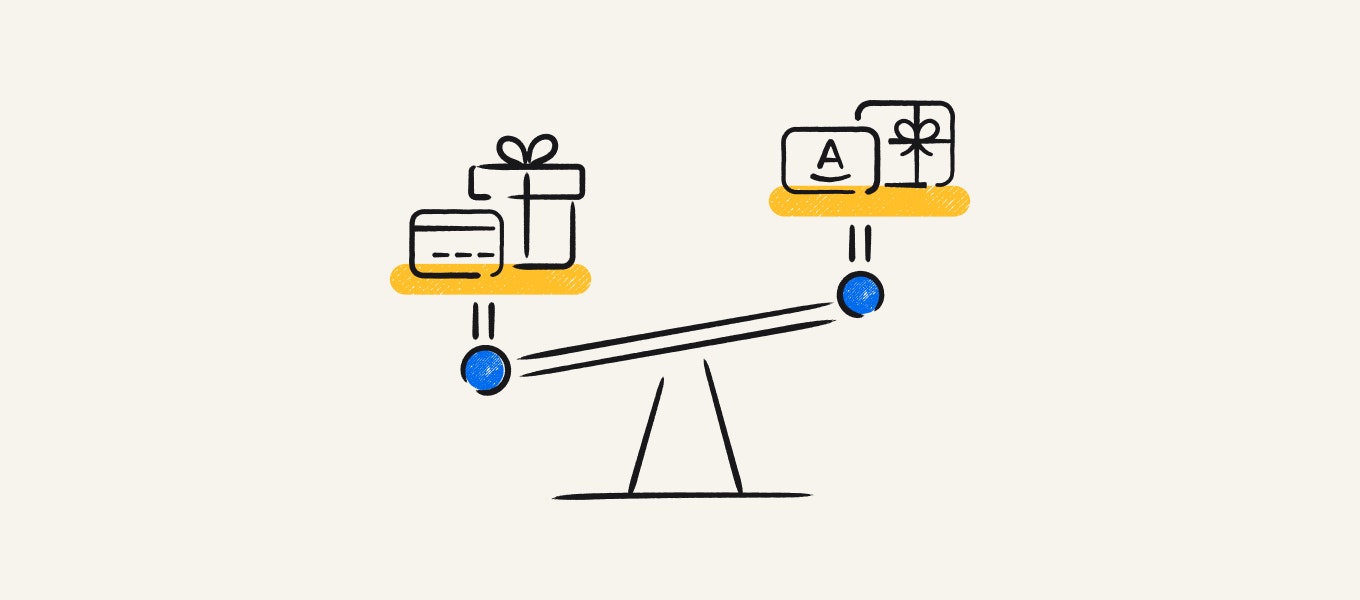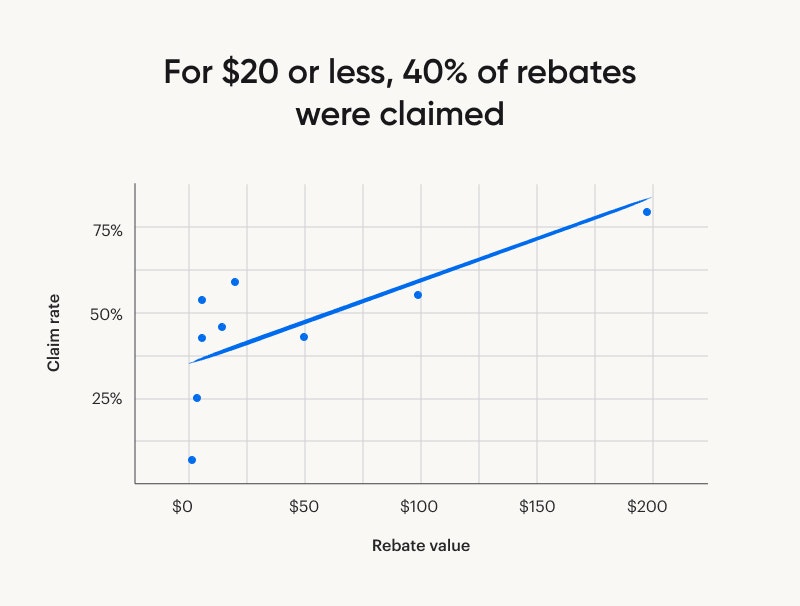Rebates vs discounts: Differences, examples, & more
By Ian Floyd, Kate Monica, and The Decision Lab●6 min. read●Dec 8, 2025

Key takeaways:
A discount is an immediate price reduction that needs no additional effort from the consumer.
A rebate is a promise of money back after purchase, and typically requires the consumer to complete a task to receive the payment.
Consumers prefer discounts. According to our research, a 10% discount can boost sales 20%, compared to just 18% for a rebate.
However, rebates are more cost effective because only 38% to 80% of consumers actually claim them. The higher the rebate, the higher the claim rate.
In the world of consumer promotions, both discounts and rebates are ubiquitous. But there are key differences between a rebate and a discount that make one a better tool than the other.
What is a consumer rebate?
A rebate is a conditional promotion, meaning that the consumer has to claim the savings. They don’t just automatically receive them. As a result of that additional effort, not all rebates will be redeemed. In other words, you’ll sell a fair chunk of the product at full price.
Marketers often add rebates to their sales promotion programs when they:
Don’t have the budget to offer a meaningful discount
Want to avoid training customers to expect lower prices in the future
Examples of rebates
Rebate program examples are everywhere. They just don't always call themselves rebates.
Cashback with purchase: These are your bread-and-butter rebate programs. A consumer purchases a good or service, and they receive money or a gift card in return.
Sign-up incentives: These rebate programs are common in commoditized or highly regulated markets. For example, if you have to choose between two internet service providers, you might select the one that's offering a $100 Visa prepaid card for signing up.
Mail-in rebates: These reimbursements require the customer to mail you proof of purchase, which can significantly reduce redemption rates.
Volume rebates: These are dollars returned to the customer if they buy a certain number of items or spend a specific amount. For example, “buy six boxes of cereal this month and get 10% back.”
Competitor price match: This is a guarantee that if a customer finds a better price elsewhere, you’ll refund the difference.
Loyalty rebates: These are like rewards for customers who continue to buy from you over and over.
Instant rebate: These are basically just discounts because instant rebates occur at the time of purchase. But you might run across the term “instant rebate” as you plan your promotion.
What are the benefits of giving consumers rebates?
Rebate marketing increases sales without forcing the seller to drop their price (in the form of a discount).
These types of promotions can convince customers to buy more products. And because rebates are conditional (meaning consumers have to follow specific rules to claim them), not everyone cashes out. This can keep margins high while still boosting sales.
What is a discount?
A discount is a reduction in the purchase price of a good or service. Discounts are simple: You sell something, and that thing has a standard price. But instead of charging the standard price, you sell it for a little less. Consumers love discounts.
Marketers use discounts when they want a simple, straightforward promotion that attracts more customers.
Examples of discounts
Product or service discounts are ubiquitous, from car sales to appliances. And they’re often tied to specific promotions or seasonal events.
Black Friday and Cyber Monday: These are the biggest consumer promotion events of the year, offering steep discounts on all types of products.
Manufacturer discounts: Sometimes a manufacturer is sitting on too much inventory and needs to move the product, so they'll offer retailers discounts to buy.
What are the benefits of discounts?
Discounts immediately benefit the consumer at the time of purchase, and they often increase sales volume. But using discounts too frequently can train customers to wait for sales.
Differences between rebates and discounts at a glance
| Discounts | Rebates |
|---|---|
| Claimed at the point of sale | Reimbursed later |
| Simple and straightforward | Complex and requires mental math |
| No additional work for the consumer | Adds hoops for the consumer to jump through |
| 100% redemption rate | Redemption rate depends on value and difficulty |
Rebate vs. discount: What's better?
In most cases, rebates are a more efficient use of marketing budget than a discount of equal value.
Discounts are simpler to implement, and they drive higher sales.
Rebates can yield almost as many sales, but requires ⅓ of the budget on average, because not everyone claims rebates.
Unless you expect a 90% claim rate — and our experiments suggest claim rates are much lower — it’s generally more cost effective to offer a rebate.
We teamed up with The Decision Lab (TDL), an applied research and innovation firm, to prove that rebates are superior. To do so, we explore the two most important considerations that separate rebates from discounts:
The value that consumers place on a rebate versus a discount
How likely someone is to actually claim a rebate at different dollar amounts
Discount vs rebate: How (and why) they work
Rebates benefit from some idiosyncrasies in human psychology: people overestimate the likelihood that they’ll claim a rebate.
This tendency towards optimism means that consumers perceive rebate offers as more valuable than they are. And that’s the key for maximizing your promotions budget.
Consumer perception: The difference between rebates and discounts, with an example
If presented with a rebate and a discount of equal value, people prefer discounts. We measured it. It’s true. But even with that preference, rebates are still better.
In our rebate vs discount experiment:
We sold a $950 washing machine.
We offered incentives between 10% and 40% of the sales price.
We served people two options, and asked them to tell us which is the better deal. Some were rebates. Others were discounts.
Based on consumers’ choices, we modeled the relative value of a discount and rebate.
Turns out, people see rebates as 9.9% less valuable than discounts.
So, on a $1,000 product, a 10% incentive is more valuable as a discount. It’s perceived as being worth $100 as a product discount. Or, $90 as a rebate. If you stop thinking here, then a discount is a no-brainer.
But a $100 discount has a 100% redemption rate. What redemption rate does a $100 rebate have?
How effective are rebates? Do they reduce revenue?
We ran an experiment to determine how often digital rebates are claimed:
275 people were offered a chance to claim a rebate.
Each was randomly assigned an offer — from $0.50 to $200 — paid out through Tremendous.
Participants were prompted to provide their email address in exchange for the rebate offer.
Three business days later, they received an email with instructions on how to claim their rebate.

For a rebate of $20 or less, only 38% were claimed. (This is higher than the 30% benchmark established decades ago for mail-in rebates, but not by much.)
It’s a little less than 50% for rebates of $50.
The claim rate never reached 100% — only 4 of the 5 people offered $200 followed through on their extra payment.
To return to our example, around 60% of people claimed a $100 rebate.
Rebate vs discount: When does a rebate win?
Short answer: pretty much always.
The long answer requires some math.
Let’s start with a few assumptions before we walk through the example:
You’re already expecting to sell 10,000 units
Your product costs $1,000
You’ll be offering an incentive of $100, or 10% of the cost of the product
Your product has a promotional elasticity of 2. That means that for every 10% off of the price of your product, you can expect to increase your sales by 20%
| Parameter | Discount | Rebate |
|---|---|---|
| Assumed baseline sales | 10,000 | 10,000 |
| Product price | $1,000 | $1,000 |
| Offer value | $100 | $100 |
| Promotional elasticity | 2 | 2 |
| Perceived offer value | $100 | $90 |
| % increase in sales | 20% | 18% |
| Total sales | 12,000 | 11,800 |
That gives us enough to start exploring the differences between a rebate and a discount.
The 10% discount can be expected to increase sales by 20%, so you’ll sell 12,000 units
We know that the rebate is perceived as less valuable. It will feel like it’s worth $90, or 9% of the cost of the product.
This means that the rebate can be expected to increase sales by 18%, so you’ll sell 11,800 units.
| Parameter | Discount | Rebate |
|---|---|---|
| Claim rate | N/A | 60% |
| Claimed incentives | 12,000 | 7,080 |
| Incentive cost | $1,200,000 | $708,000 |
| Cost per additional sale | $600 | $393.33 |
With the discount, 12,000 sales means that you give out 12,000 incentives.
The cost of the campaign would be $1,200,000
That’s a cost per additional sale of $600
For rebates, our experiment suggests a claim rate of approximately 60%.
You would expect to actually pay out 7,080 rebates
The cost of the rebate campaign would be $708,000
That’s a cost per additional sale of $393.33
Why are rebates better than discounts?
Rebates are way better for profit margins than discounts.
You will generate about 10% fewer additional sales through a rebate program
However, in this example, spend 33% less to still get 90% of the sales
In our example above, the rebate program costs 33% less. Savings will vary depending on the expected claim rate, but in general, a rebate is more cost effective than a discount even at a claim rate of 90%.
The largest rebate in our experiment — $200 — only had a claim rate of 80%.
When in doubt, your best bet is to go with a rebate.
How to set up a DIY rebate program
If you’ve never offered a rebate before, it’s worth it to try.
You don’t need to enlist the help of an outside company to run your rebate program, either. It’s easier to set up a rebate program than you’d think. We put together a quick-start guide for using Tremendous to run a consumer rebate program.

